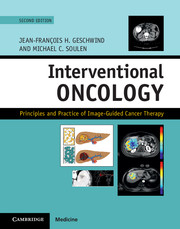Book contents
- Frontmatter
- Contents
- List of contributors
- Section I Principles of oncology
- Section II Principles of image-guided therapies
- Section III Organ-specific cancers – primary liver cancers
- Section IV Organ-specific cancers – liver metastases
- 16 Colorectal masses: Ablation
- 17 Assessment, triage, and chemoembolization for colorectal liver metastases
- 18 Radioembolization for colorectal liver metastases
- 19 Assessment, triage, and liver-directed therapies for neuroendocrine tumor metastases
- 20 Preoperative portal vein embolization
- Section V Organ-specific cancers – extrahepatic biliary cancer
- Section VI Organ-specific cancers – renal cell carcinoma
- Section VII Organ-specific cancers – chest
- Section VIII Organ-specific cancers – musculoskeletal
- Section IX Organ-specific cancers – prostate
- Section X Specialized interventional techniques in cancer care
- Index
- References
20 - Preoperative portal vein embolization
from Section IV - Organ-specific cancers – liver metastases
Published online by Cambridge University Press: 05 September 2016
- Frontmatter
- Contents
- List of contributors
- Section I Principles of oncology
- Section II Principles of image-guided therapies
- Section III Organ-specific cancers – primary liver cancers
- Section IV Organ-specific cancers – liver metastases
- 16 Colorectal masses: Ablation
- 17 Assessment, triage, and chemoembolization for colorectal liver metastases
- 18 Radioembolization for colorectal liver metastases
- 19 Assessment, triage, and liver-directed therapies for neuroendocrine tumor metastases
- 20 Preoperative portal vein embolization
- Section V Organ-specific cancers – extrahepatic biliary cancer
- Section VI Organ-specific cancers – renal cell carcinoma
- Section VII Organ-specific cancers – chest
- Section VIII Organ-specific cancers – musculoskeletal
- Section IX Organ-specific cancers – prostate
- Section X Specialized interventional techniques in cancer care
- Index
- References
Summary
With advances in perioperative care, major liver resections are being increasingly performed for primary and metastatic liver tumors. Although fatal liver failure and major technical complications are now rare after resection, complications associated with cholestasis, fluid retention, and impaired synthetic function still contribute to protracted recovery time and extended hospital stay. Although the risk for perioperative liver failure is multifactorial, one of the most important factors associated with this complication is the volume of functional liver remaining after surgery. Patients considered at high risk are those with normal underlying liver in whom more than 80% of the functional liver mass will be removed or those with chronic liver disease who undergo resection of more than 60% of their functional liver mass.
One strategy used to improve the safety of extensive liver surgery in patients with small remnant livers is preoperative portal vein embolization (PVE). PVE redirects portal flow to the intended future liver remnant (FLR) in an attempt to initiate hypertrophy of the non-embolized segments, and PVE has been shown to improve the functional reserve of the FLR before surgery. In appropriately selected patients, PVE can reduce perioperative morbidity and allow for safe, potentially curative hepatectomy for patients previously considered ineligible for resection based on anticipated small remnant livers. For this patient subset, PVE is now utilized as the standard of care at many comprehensive hepatobiliary centers prior to major hepatectomy.
The clinical use of PVE is based on experimental observations first reported in 1920 by Rous and Larimore, who studied the consequences of segmental portal venous occlusion in rabbits and found progressive atrophy of the hepatic segments with ligated portal veins and hypertrophy of the hepatic segments with patent portal veins. Later investigators reported clinical studies showing that portal vein or bile duct occlusion secondary to tumor invasion or ligation leads to ipsilateral liver atrophy (i.e., liver to be resected) and contralateral liver hypertrophy (i.e., liver to remain in situ after resection). In the mid-1980s, Kinoshita et al. used PVE to limit extension of segmental portal tumor thrombi from hepatocellular carcinoma (HCC) for which transcatheter arterial embolization (TAE) was ineffective. In 1990, Makuuchi et al. first reported the use of PVE solely to induce left-liver hypertrophy prior to major hepatic resection in 14 patients with hilar cholangiocarcinoma.
- Type
- Chapter
- Information
- Interventional OncologyPrinciples and Practice of Image-Guided Cancer Therapy, pp. 176 - 192Publisher: Cambridge University PressPrint publication year: 2016

